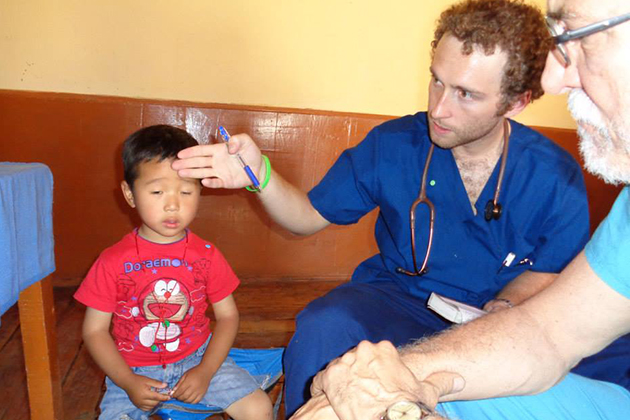
Harrison Hayward, originally from Winter Springs, Fla., is a second-year student at the UConn School of Medicine who spent part of last summer working in Nepal. Hayward provided health care to people in remote villages in the southern Himalayas, the same region hit by the Nepal earthquake that injured and killed thousands this week.
Hayward will be honored in June with the American Medical Association’s 2015 Leadership Award for his work with the physically disabled in Hartford and internationally in the Himalayas. Locally, he founded a recreational support group for people with disabilities and their families in the greater Hartford area during his first year of medical school, and he is also the leader of the area’s Special Olympics program.
Hayward’s three siblings all have mental disabilities that make it hard for them to speak and care for themselves. They made him realize that everyone deserves to have decent health care, and inspired his public service both in the U.S. and abroad. He spoke with UConn Today about volunteering with a medical team in the Himalayas, what conditions were like before the earthquake, and how the challenges faced by doctors in Nepal are likely to have been magnified since the disaster struck.
What sparked your interest in the Himalayas?
The Himalayas … I’d never left the country before. I went to the Himalayas specifically so I could help people who really have no other resources. So I went through this program called the Himalayan Health Exchange.
What leapt out at you when you first arrived in the Himalayas?
The way our culture is here, when you go to the Third World, you’re a little afraid of what you might see. I don’t think that fear could have been more opposite to my actual experience. The people in the Himalayas had so little, but they were the most generous people I had ever met. They’ll give you the shirt off their back – and that might literally be the only thing they have with them that day. They’ll share their food with you, and they’ll talk with you, and there’s really nothing to fear.
What were the primary medical needs that you saw and served?
The workforce was primarily doing manual labor type things, like working the land or moving things from one place to another. Not a lot of the jobs there involve sitting in front of a computer all day! Because of this, a lot of the medical issues that they had were orthopedic: bone pain or back pain. Also, the environment is less sterile than here, so there were a lot of things like skin infections. Their dentition, their teeth … none of it was to the standards that you might have here. So a lot of what we treated were skin conditions or bone conditions, and things like that.
What were the roads like and how did you get around?
We flew into New Delhi, then we took a smaller plane into Leh, and then we drove jeeps around. We set up camp in a number of places in the China-India-Nepal border region. We often wouldn’t take roads. It was so remote. We’d traverse streams and drive across bare land, taking two hours, some days four or six hours, to get from one place to another.
When I heard about the earthquake, honestly, I was crushed. These are some of the kindest, most generous people, and they don’t deserve to be impacted by a disaster like that.
From what you saw while you were there, how would the earthquake impact the medical team’s work?
What makes it hard is that it’s difficult to get from one settlement, that might not have been as affected, to a neighboring settlement that needs help, because there’s no infrastructure like roads. Not to mention that it’s not as if the unaffected settlement has a surplus of resources to offer. They’re all remote. So it’s a really difficult situation in terms of providing aid.
Have you spoken with anyone from your Himalayan Health Exchange team since the earthquake?
I just heard back from the team over in India. For the past couple of weeks, they’ve been stationed in Dharamshala to the northwest of Nepal. They themselves were unaffected, but what they’ve identified as the largest problem is space for people to live. Those who managed to survive in the areas that were directly impacted are now without homes. They’ve been struggling to find a roof to put over their heads. They described to me people sleeping on streets and under balconies. The team is attempting to house these people in their facilities and raise money through the Himalayan Health Center Foundation to construct new houses for them. Their goal is $8,000 U.S., which may not seem like much, but you would be shocked how far $8,000 will go in this region.
If you could send them a care package, what would you send?
They are trying to collect bandages, dressings, and vitamins for villages in the Pokhara region of Nepal. Not a bad idea for a care package!



